
7 World Trade Center is an office building constructed as part of the new World Trade Center in Lower Manhattan, New York City. The tower is located on a city block bounded by Greenwich, Vesey, Washington, and Barclay Streets on the east, south, west, and north, respectively. It was developed by Larry Silverstein, who holds a ground lease for the site from the Port Authority of New York and New Jersey, and designed by Skidmore, Owings & Merrill.
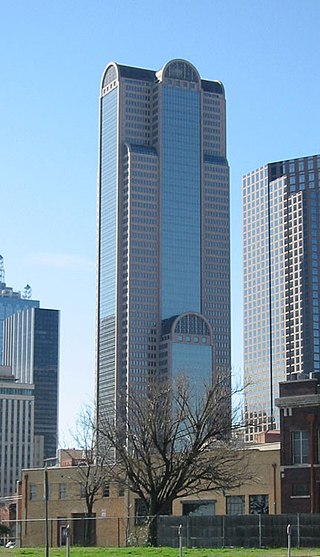
Comerica Bank Tower is a 60-story postmodern skyscraper located at 1717 Main Street in the Main Street District in downtown Dallas, Texas. Standing at a structural height of 787 feet (240 m), it is the third tallest skyscraper in the city of Dallas. It is also the sixth tallest building in Texas and the 61st tallest building in the United States. The building was designed by Philip Johnson and John Burgee, and was completed in 1987. The structure has 1,500,000 square feet (100,000 m2) of office space.

Dallas Arts Tower (formerly Chase Tower) is a 225 m (738 ft), 55-story postmodern skyscraper at 2200 Ross Avenue in the City Center District of downtown Dallas, Texas. Although it is the fourth tallest skyscraper in the city, if one were to exclude antennas and spires, it would be the third. It is also the 12th tallest building in Texas. The building was designed by Skidmore, Owings & Merrill and was completed in 1987. The building also formerly housed the Dallas Petroleum Club, a business and social club located on the 39th and 40th floors.
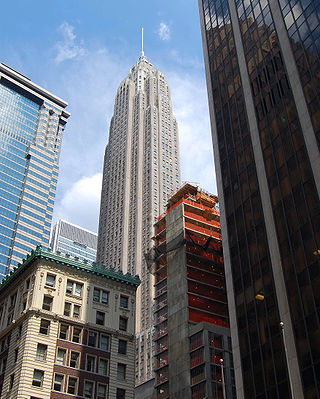
70 Pine Street is a 67-story, 952-foot (290 m) residential building in the Financial District of Lower Manhattan in New York City. Built from 1930 to 1932 by energy conglomerate Cities Service Company, the building was designed by the firm of Clinton & Russell, Holton & George in the Art Deco style. It was Lower Manhattan's tallest building and the world's third-tallest building upon its completion.

40 Wall Street is a 927-foot-tall (283 m) neo-Gothic skyscraper on Wall Street between Nassau and William streets in the Financial District of Manhattan in New York City. Erected in 1929–1930 as the headquarters of the Manhattan Company, the building was designed by H. Craig Severance with Yasuo Matsui and Shreve & Lamb. The building is a New York City designated landmark and is listed on the National Register of Historic Places (NRHP); it is also a contributing property to the Wall Street Historic District, an NRHP district.

Pearl Street Station was the first commercial central power plant in the United States. It was located at 255–257 Pearl Street in the Financial District of Manhattan, New York City, just south of Fulton Street on a site measuring 50 by 100 feet. The station was built by the Edison Illuminating Company, under the direction of Francis Upton, hired by Thomas Edison.

1 Wall Street is a mostly residential skyscraper in the Financial District of Lower Manhattan, New York City, on the eastern side of Broadway between Wall Street and Exchange Place. 1 Wall Street, designed in the Art Deco style, is 654 feet (199 m) tall and consists of two sections. The original 50-story building was designed by Ralph Thomas Walker of the firm Voorhees, Gmelin and Walker and constructed between 1929 and 1931, while a 36-story annex to the south was designed by successor firm Voorhees, Walker Smith Smith & Haines and built between 1963 and 1965.

The W. R. Grace Building is a skyscraper in Manhattan, New York City. The building was designed principally by Gordon Bunshaft, and completed in 1972. The building was commissioned by the W.R. Grace Company, and was also used by the Deloitte & Touche, LLP.
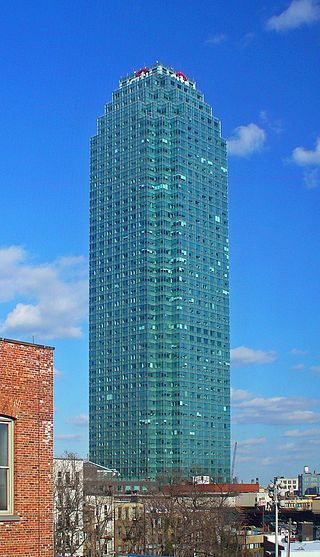
One Court Square, also known as the Citicorp Building or the Citigroup Building, is a 50-story, 673-foot (205 m) office tower in Long Island City, Queens, across the East River from Manhattan in New York City, United States. It was completed in 1989 and designed by Skidmore, Owings & Merrill for Citigroup. The building was the tallest in Queens from its completion until the topping out of Skyline Tower in 2019, and for many years was the only skyscraper in Long Island City. It is now home to telecommunications firm Altice USA, whose logo adorns the top of the building, among other tenants.

The building form most closely associated with New York City is the skyscraper, which has shifted many commercial and residential districts from low-rise to high-rise. Surrounded mostly by water, the city has amassed one of the largest and most varied collection of skyscrapers in the world.
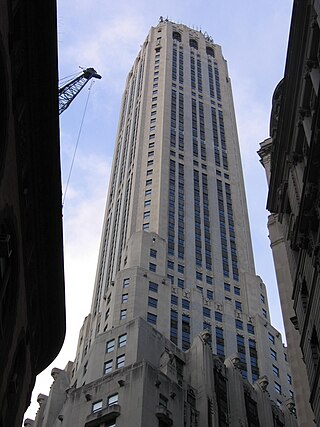
20 Exchange Place, formerly the City Bank–Farmers Trust Building, is a skyscraper in the Financial District of Lower Manhattan in New York City. Completed in 1931, it was designed by Cross & Cross in the Art Deco style as the headquarters of the City Bank–Farmers Trust Company, predecessor of Citigroup. The building, standing at approximately 741 feet (226 m) with 57 usable stories, was one of the city's tallest buildings and the world's tallest stone-clad building at the time of its completion. While 20 Exchange Place was intended to be the world's tallest building at the time of its construction, the Great Depression resulted in the current scaled-back plan.

The Mercantile National Bank Building is a 31-story, 159.4 m (523 ft) skyscraper at 1800 Main Street in the Main Street district of downtown Dallas, Texas. It is the former home of the Mercantile National Bank, which later became MCorp Bank. The design of the skyscraper features Moderne styling from the Art Deco era and was designed by Walter W. Ahlschlager. The building has a series of setbacks that is crowned by an ornamental four-sided clock along with a decorative weather spire. The Merc was the main element of a four-building complex that eventually spanned a full city block.

33 Thomas Street is a 550-foot-tall (170 m) windowless skyscraper in the Tribeca neighborhood of Lower Manhattan in New York City, New York, United States. It stands on the east side of Church Street, between Thomas Street and Worth Street. Designed in the Brutalist architectural style, it is a telephone exchange or wire center building which contained three major 4ESS switches used for interexchange telephony, as well as a number of other switches used for competitive local exchange carrier services. However, it is not used for incumbent local exchange carrier services, and is not a central office.

277 Park Avenue is an office building in the Midtown Manhattan neighborhood of New York City. It stands on the east side of Park Avenue between East 47th and 48th Streets, and is 687 feet (209 m) tall, with 50 floors. It is tied with two other buildings, 55 Water Street and 5 Beekman Street, as the 73rd tallest building in New York. The building is assigned its own ZIP Code, 10172; it was one of 41 buildings in Manhattan that had their own ZIP Codes as of 2019.
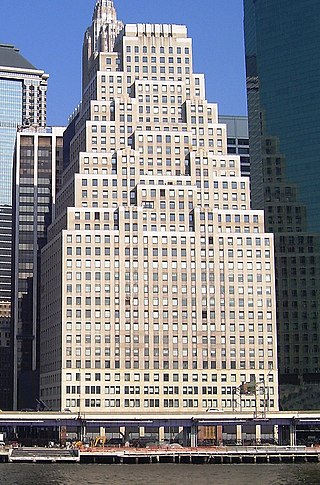
120 Wall Street is a skyscraper in the Financial District of Lower Manhattan in New York City. It was completed in 1930. The building is 399 ft tall, has 34 floors, and is located on the easternmost portion of Wall Street, and also borders Pine Street and South Street. The architect was Ely Jacques Kahn of Buchman & Kahn.

Sven is a residential building located at 29-59 Northern Boulevard in the Long Island City neighborhood of Queens, New York City. At 762 feet (232 m) tall, Sven is the second-tallest building in Queens behind Skyline Tower, as well as one of the tallest buildings in New York City outside of Manhattan.

The AMT Theater, formerly the Davenport Theatre is an Off-Broadway theater venue located at 354 West 45th Street between Eighth and Ninth Avenues in the Hell's Kitchen neighborhood of Manhattan, New York City. It was operated by Off-Broadway producer Ken Davenport in a building owned by Gran Logia de Lengua Española Vales De Nueva York.
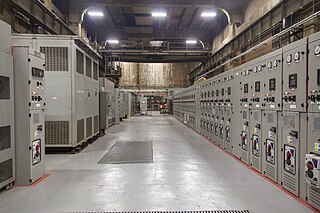
M42 is a sub-basement of Grand Central Terminal in Midtown Manhattan, New York City. The basement contains an electrical substation that provides electricity to the terminal and helps power its tracks' third rails.

Waterside Generating Station was a power station in Manhattan, New York City that opened in 1901 and was one of the first power plants in the United States that generated electricity using steam turbines. Built by the New York Edison Company, the facility was located in the Murray Hill neighborhood on the east side of First Avenue between East 38th and 40th streets alongside the East River. The Waterside station also later served as a cogeneration facility and generated steam for the New York City steam system.




















